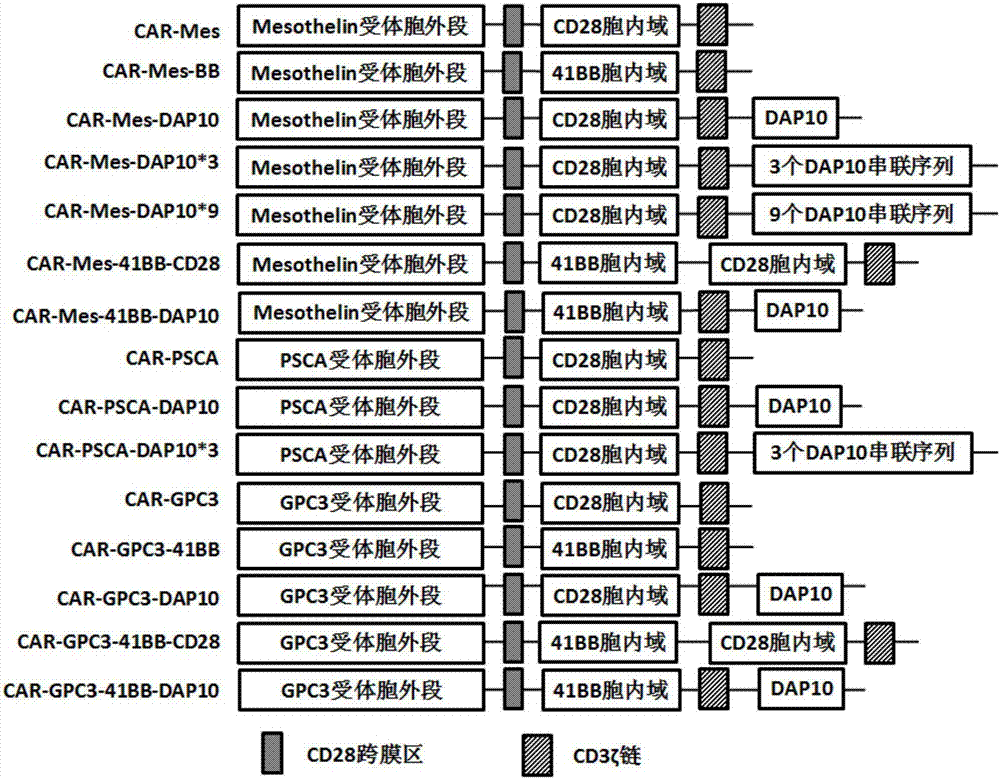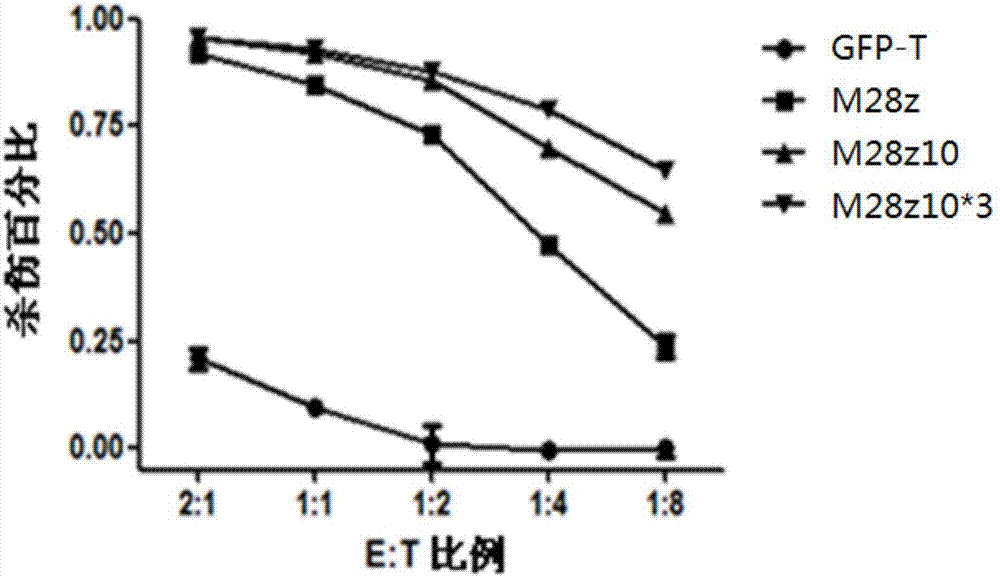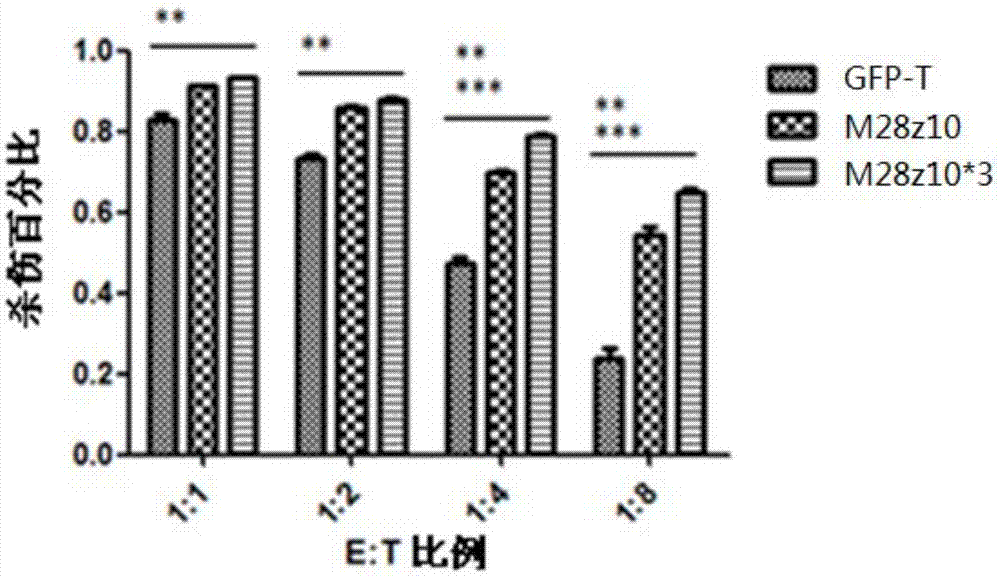Nucleic acid molecule for enhancing antitumor activity of T cells
A cell and nucleic acid technology, used in the preparation of drugs for the treatment of tumors and the field of chimeric antigen receptors, can solve the problems of weakened CART cell proliferation and survival ability, unsustainable number of CART cells, and difficult to carry out.
- Summary
- Abstract
- Description
- Claims
- Application Information
AI Technical Summary
Problems solved by technology
Method used
Image
Examples
Embodiment 1
[0062] Embodiment 1, construction of CAR plasmid
[0063] 1) Through gene synthesis, respectively synthesize CAR-Mes (control group), CAR-Mes-DAP10, CAR-Mes-41BB, CAR-Mes-DAP10*3, CAR-Mes-DAP10*9, CAR-Mes-41BB- CD28, CAR-Mes-41BB-DAP10, CAR-PSCA (control group), CAR-PSCA-DAP10, CAR-PSCA-DAP10*3, CAR-GPC3 (control group), CAR-GPC3-41BB, CAR-GPC3- DAP10, CAR-GPC3-41BB-CD28, CAR-GPC3-41BB-DAP10 molecules (the schematic diagram of each molecule is shown in figure 1 shown), the C-terminal of the synthetic gene contains a restriction endonuclease Pme1 restriction site and its protective base and the N-terminus contains a restriction endonuclease AsiSI restriction site and its protective base; wherein, "41BB" It means that the molecule contains the intracellular signaling domain 4-1BB commonly used in the prior art.
[0064] For the gene sequence of each molecule synthesized, please refer to SEQ ID NO: 2 (CAR-Mes), SEQ ID NO: 3 (CAR-Mes-DAP10), SEQ ID NO: 4 (CAR-Mes-41BB), SEQ ID ...
Embodiment 2
[0068] Example 2, lentiviral packaging of CAR plasmid
[0069] The CAR plasmid of the present invention prepared in Example 1 and related control plasmids were packaged with lentivirus, and the specific steps were as follows:
[0070] 1) Cultivate 293T cells in a 10cm culture dish, the medium is: DMEM high glucose medium + 10% FBS (fetal bovine serum) + 1% double antibody (100 × penicillin-streptomycin mixed solution);
[0071] 2) When the 293T cell density in the 150mm culture dish reaches 80-90%, replace the medium: DMEM high glucose medium + 1% FBS + 1% double antibody;
[0072] 3) After replacing the medium and culturing for 2-6 hours, use PEI to separate the LEGO-CAR-EGFP plasmids (LEGO-CAR-Mes-2A-EGFP, LEGO-CAR-Mes-41BB-2A-EGFP, LEGO-CAR-Mes -DAP10-2A-EGFP, LEGO-CAR-Mes-DAP10*3-2A-EGFP, LEGO-CAR-Mes-DAP10*9-2A-EGFP, LEGO-CAR-Mes-41BB-CD28-2A-EGFP, LEGO -CAR-Mes-41BB-DAP10-2A-EGFP, LEGO-CAR-PSCA-2A-EGFP, LEGO-CAR-PSCA-DAP10-2A-EGFP, LEGO-CAR-PSCA-DAP10*3-2A-EGFP, LEGO -C...
Embodiment 3
[0079] Example 3, T cell activation and CAR lentivirus infection
[0080] ① Separation and purification of T cells: The mononuclear cells in the blood were separated by the Ficoll density gradient method, and the red blood cells were removed by lysing with the red blood cell lysate, and then the T cells were sorted by MACS Pan-T magnetic beads;
[0081] ② Dilute the sorted T cells with medium (AIM-V medium + 5% FBS + penicillin 100U / ml + streptomycin 0.1mg / ml to a cell concentration of 2.5×10 6 pcs / ml for use;
[0082] ③ Stimulate T cells by magnetic beads coated with CD2, CD3, and CD28 antibodies (product source: Miltenyi, Germany), that is, the coated magnetic beads and T cells are mixed at a ratio of 1:2, and the final density of T cells should be 5×10 6 A / ml / cm2. After mixing, place at 37°C, 5% CO 2 Incubate the stimulus for 48 hours in the incubator.
[0083] ④Lentiviral transfection of T cells: remove the magnetic beads in the activated T cell-magnetic bead mixture b...
PUM
 Login to View More
Login to View More Abstract
Description
Claims
Application Information
 Login to View More
Login to View More - R&D
- Intellectual Property
- Life Sciences
- Materials
- Tech Scout
- Unparalleled Data Quality
- Higher Quality Content
- 60% Fewer Hallucinations
Browse by: Latest US Patents, China's latest patents, Technical Efficacy Thesaurus, Application Domain, Technology Topic, Popular Technical Reports.
© 2025 PatSnap. All rights reserved.Legal|Privacy policy|Modern Slavery Act Transparency Statement|Sitemap|About US| Contact US: help@patsnap.com



